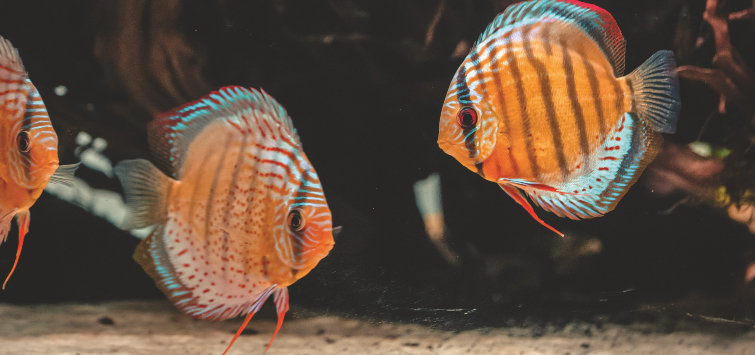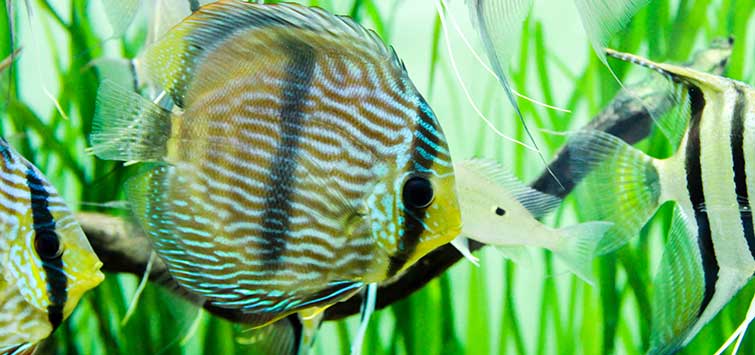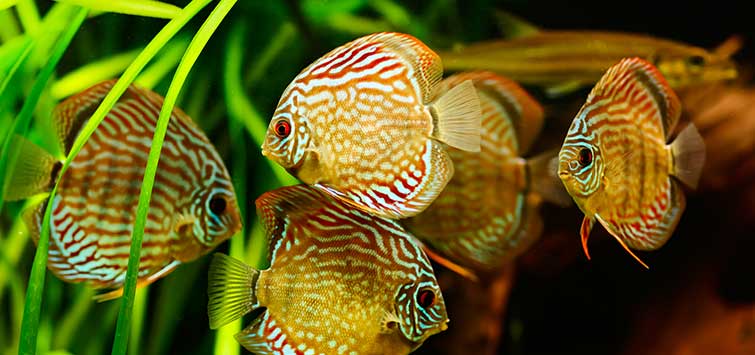Recreating a Wild Discus Aquascape
Kire Hajba
When I saw my first red spotted green discus it was love at first sight, and I decided to learn everything I’d need to know to keep them. Keeping wild fish for me is very special. It makes me feel like I’m looking directly into the soul of the Amazon River, learning and observing something new every day. In my opinion, wild fish display much more diverse behavior than their captive-bred cousins.
Wild discus live in slow-moving waters, in groups with well-established hierarchies. For successful discus keeping, a group of at least nine fish is essential. This allows the natural hierarchy to establish properly, with any pecking order distributed among the lower members, managing stress collectively. In smaller groups, the lowest-ranking fish bear all the stress from higher-ranking members, often preventing them from eating properly and eventually leading to their demise.
Discus live for 10 to 15 years and grow to about 5 to 6 inches (13 to 15 cm). I advise starting with at least a 125-gallon (500-liter) aquarium for a group of 10. Having a bigger tank maximizes your chances of success by providing more swimming and hiding space, maintaining cleaner water despite discus being messy eaters, and offering a larger margin of error through increased water stability.
When setting up a wild discus tank, think about their natural habitat. Discus are easily frightened fish that live surrounded by roots and fallen branches, where they hide when threatened. Creating this environment is crucial for their well-being and natural behavior.
Enjoying TFH Magazine? Subscribe Today!

Selecting and Preparing Driftwood
The key to a successful discus aquascape starts with thoughtful hardscape selection. I prefer using pieces of driftwood that create both vertical and horizontal elements, mimicking the fallen trees and branches of the Amazon. Spider wood and manzanita branches work exceptionally well, as their intricate branching creates numerous hiding spots and visual barriers that help establish territories. It important to select wood that is healthy and well-cleaned.
When arranging driftwood, I create distinct zones within the aquarium. Place larger pieces strategically to break the line of sight across the tank, which reduces aggression and gives subordinate fish areas of refuge. I often position branches at angles, leaning them against the back glass or other pieces to create cave-like structures underneath.
You absolutely must prepare the wood before adding it to the discus tank. Boil larger pieces and soak all wood in a large container, changing the water every few days until the wood leaches clean tannins rather than murky water. This process can take several weeks but is essential for water quality.
Substrate and Leaf Litter
The bottom should be very fine white sand—this goes beyond aesthetics, as it is essential for discus health. Discus and other cichlids use fine sand to clean their gills and spend much of their day searching through it for food. The lack of a proper substrate will almost certainly lead to gill problems.
In planted sections, I use aquarium soil contained within filter socks buried beneath the sand. This technique allows plants to access nutrients while maintaining the sandy substrate discus require. The filter sock prevents the soil from mixing with the sand during maintenance or from fish activity.
Botanicals add both aesthetic appeal and functional benefits to a discus aquascape. I incorporate Catappa leaves, magnolia leaves, and various seed pods to create a natural biotope appearance. However, extreme caution is necessary with discus water parameters.
In the warm water required for discus, about 82° to 88°F (28° to 31°C), leaf litter decomposes rapidly, sometimes within days. This creates a significant bioload that consumes oxygen. Add botanicals very slowly—just a few leaves at a time—and observe your fish carefully. Keep an air pump ready, as discus require high oxygen levels and will gasp at the surface if levels drop.
The Best Plants for Discus Tanks
Creating a planted discus tank presents unique challenges due to the high temperatures and low pH these fish require. Success depends on careful plant selection and strategic placement, but once done, it’s a gorgeous sight!
Anubias species are my go-to plants for discus aquascapes. Their thick leaves withstand the warm water, and they thrive when attached to driftwood rather than planted in substrate. I use various sizes—from tiny Anubias nana “petite” for detailed work to large A. barteri for bold statements.
Vallisneria adapts well to discus conditions once established. Plant it in the background where its long leaves create a curtain effect, providing security for the fish while softening the aquarium’s edges.

Cryptocoryne species work very well in the midground. While they may melt initially when introduced to high temperatures, they typically recover and thrive. Cryptocoryne wendtii and C. undulata are particularly hardy choices.
Sagittaria subulata creates a grassy foreground that discus enjoy swimming through. It spreads via runners, eventually forming a natural carpet.
Echinodorus species, the Amazon swordplants, are another great choice for a discus tank. They do great in hot water, and once established, the larger-growing types will shoot leaves outside the aquarium, creating a special dimension above the tank.
Advanced Planting Techniques
Root tabs are game changers for planted discus tanks. Since we’re working with inert sand substrate, plants rely entirely on these fertilizers. I place tabs deep in the sand near the plant roots, replacing them every two to three months.
One of my favorite techniques involves using emergent plants. I position Philodendron cuttings with their roots trailing into the water. These vigorous growers help maintain water quality by absorbing nutrients while their roots create additional structure for the fish to explore.
When establishing a planted discus tank, mature it without fish for several months. Start at a lower temperature, around 79°F (26°C), and gradually increase it over several weeks. This gives plants time to establish strong root systems before facing the stress of the higher temperatures.
Aquascape Composition
Creating visual impact while meeting the needs of your discus requires balancing aesthetic principles with practical requirements. I follow the rule of thirds for placing focal points, but I ensure these also serve as functional territories for different fish.
Use height variation to create interest—tall driftwood pieces in the background, medium-height plants in the midground, and low carpeting plants or sand in the foreground. This layering creates depth while providing the discus with swimming space at different levels.
Leave open sandy areas between planted sections. Discus need these spaces for their natural sand-sifting behavior and as neutral zones between territories. I typically maintain at least 40-percent open sand area in my layouts.
Lighting Techniques
Discus prefer subdued lighting, which can limit plant choices. I use moderate lighting levels and ensure that I create shady spots by strategically placing branches. If using Echinodorus, the emersed growth will create beautiful shadows as well. This mimics their natural habitat under the forest canopy, while providing enough light for shade-tolerant plants to photosynthesize.
Position the lights to highlight your hardscape and create dramatic shadows. This enhances the visual impact while keeping overall light levels comfortable for the fish.
Filtration
In a well-aquascaped discus tank, the filtration equipment should be invisible. I use spray bars positioned behind driftwood or along the back wall to create gentle, distributed flow. Strong currents stress discus, so aim for turnover rates of three to four times tank volume per hour with a well-dispersed output. Be careful not to overdo it, discus like slow water movement.
For tanks over 125 gallons/500 liters, sump filtration offers the best combination of capacity and aesthetics. Hide intake pipes behind hardscape or plant groupings. If using canister filters, choose models with high media capacity and clean them frequently—every two weeks in heavily stocked discus tanks.

Maintenance and Longterm Success
Maintaining an aquascaped discus tank requires dedication. I perform 10-percent daily automated water changes, though 30-percent weekly changes work well for most setups. During weekly water changes, use a small-diameter siphon to clean debris from the sand without disturbing the aquascape.
Trim plants regularly to maintain your planted tank. Fast-growing stems may need weekly attention, while slower growers like Anubias require only occasional removal of old leaves. Remove and replace botanicals before they decompose completely.
The ultimate goal of a discus aquascape is creating an environment where these magnificent fish display their natural behaviors. When your tank is successful, you’ll observe:
• Fish using different areas throughout the day
• The establishment of a natural hierarchy without excessive aggression
• Confident swimming in open areas rather than constant hiding
• Natural spawning behavior on vertical surfaces
• Active foraging through sand and around hardscape
Creating the Essence of a Natural Habitat
Aquascaping for discus requires patience, observation, and a willingness to prioritize fish needs over purely aesthetic choices. By thoughtfully combining appropriate hardscape, carefully selected plants, and proper maintenance, you can create a stunning display that showcases both the beauty of these kings of the aquarium and the art of aquascaping. The result is a living piece of the Amazon that brings daily joy while providing your discus with an environment where they truly thrive.
Remember, successful discus aquascaping is a journey. Start simple, observe your fish’s behavior, and refine your design over time. The reward is an aquarium that captures the essence of their natural habitat while displaying these remarkable fish at their very best.

.png?h=595&iar=0&w=2781&hash=5FD5E69473BCC22199FBFA2FB71B6033)



